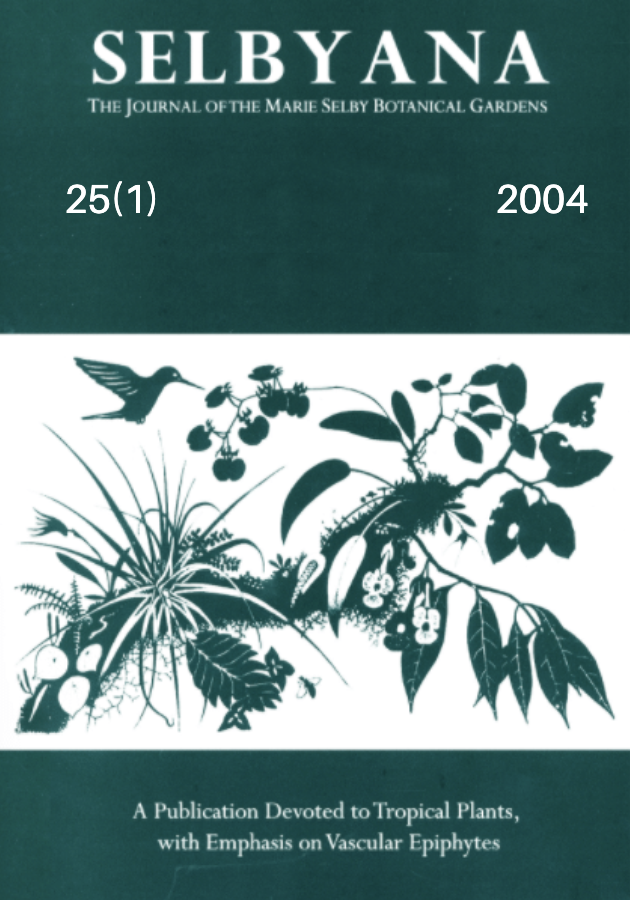Abstract
In Central Guatemala, emergent trees and trees with high epiphytic loads (temperate subtropical forest, cloud forest, and evergreen tropical forest) were examined to determine if tree height or emergent status determined high species diversity. Height did not correlate with epiphyte diversity, nor did any of the other examined parameters. Isolated trees, however, in contrast to those in forests supported fewer epiphyte species, although numbers of plants were greater. The emergent trees hosted the most epiphytic life forms, 35% of all rare epiphytic species, and the highest proportion of non-vascular epiphytes. Of the rare epiphytes, 71% were non-vascular species. Emergent trees, therefore, may host the most rare species and the highest life-form diversity. Non-vascular diversity increased as did humidity or dryness. Lichen species diversity apparently depended on specific phorophyte species, on branch strata, and on the emergent status of the host tree. Rare species were correlated with non-vascular species. Microclimate, especially humidity, appeared to be the major determinant of epiphyte diversity in Central Guatemala. En Guatemala árboles sobresalientes y árboles con gran carga de epífitas se examinaron (bosque templado subtropical, bosque nuboso subtropical y bosque tropical siempre verde) para averiguar si es la altura o el hecho de sobresalir el dosel lo que determina alta diversidad. Ni altura fue correlacionado con alta diversidad de epífitas ni ningún otro determinante examinado. Pero los árboles aislados llevaban una diversidad de epífitas más baja en comparación con árboles dentro del bosque, no obstante la cantidad de plantas fue más alta. Los árboles sobresalientes alojan la variedad más alta de formas de vida de epífitas, un 35% de especies raras y el más alto porcentaje de epífitas no vasculares. Un setenta y un porciento de las especies raras son no vasculares. Por esto los árboles sobresalientes representan el potencial más alto de epífitas raras y una alta diversidad de formas de vida de epífitas. La diversidad de briofitas aumenta con un incremento de humedad y de sequía. La diversidad de especies de liqúenes parece depender más de la especie del forofito y de la cantidad de pisos de ramas y el facto de sobresalir el docel del forofito. Especies raras fueron correlacionadas con especies no vasculares. Concluyendo se puede decir que el factor microclimático, especialmente la humedad es el parámetro más importante para determinar la diversidad de epífitas.
Open Access and Copyright Notice
Selbyana is committed to real and immediate open access for academic work. All of Selbyana's articles and reviews are free to access immediately upon publication. There are no author charges (APCs) prior to publication, and no charges for readers to download articles and reviews for their own scholarly use. To facilitate this, Selbyana depends on the financial backing of the Marie Selby Botanical Gardens, the hard work and dedication of its editorial team and advisory board, and the continuing support of its network of peer reviewers and partner institutions.
Authors are free to choose which open license they would like to use for their work. Our default license is the Creative Commons Attribution-NonCommercial 4.0 (CC BY-NC 4.0). While Selbyana’s articles can be copied by anyone for noncommercial purposes if proper credit is given, all materials are published under an open-access license with authors retaining full and permanent ownership of their work. The author grants Selbyana a perpetual, non-exclusive right to publish the work and to include it in other aggregations and indexes to achieve broader impact and visibility.
Authors are responsible for and required to ascertain that they are in possession of image rights for any and all photographs, illustrations, and figures included in their work or to obtain publication or reproduction rights from the rights holders. Contents of the journal will be registered with the Directory of Open Access Journals and similar repositories. Authors are encouraged to store their work elsewhere, for instance in institutional repositories or personal websites, including commercial sites such as academia.edu, to increase circulation (see The Effects of Open Access).
